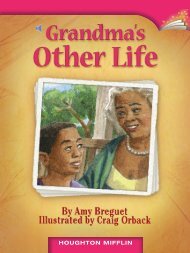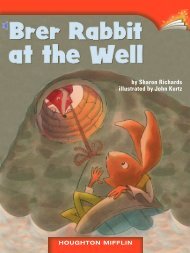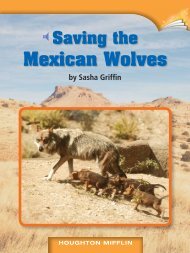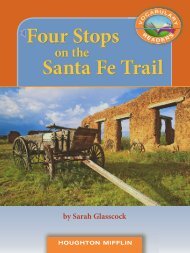You also want an ePaper? Increase the reach of your titles
YUMPU automatically turns print PDFs into web optimized ePapers that Google loves.
HOUGHTON MIFFLIN
By Dan Rosen<br />
ILLUSTRATION CREDITS: 6 Joe LeMonnier / Melissa Turk; 14 Studio Montage; 16 Mike Maydak / Craven Design<br />
PHOTOGRAPHY CREDITS: Cover © Bettmann / CORBIS; 1 © Bettmann / CORBIS; 2 © Hemera Technologies ; 3 ©<br />
Bettmann / CORBIS; 5 © Hans Strand / CORBIS; 7 © Pictorial Press Ltd / Alamy; 10-11 © Bettmann / CORBIS; 17 (bottom<br />
left and bottom right) © NSIDC/WDC for Glaciology, Boulder, compiler; Bkgrnd © PhotoDisc / Elements<br />
Copyright © by Houghton Mifflin Company. All rights reserved.<br />
No part <strong>of</strong> this work may be reproduced or transmitted in any form or by any means, electronic or mechanical,<br />
including photocopying or recording, or by any information storage or retrieval system without the prior written<br />
permission <strong>of</strong> Houghton Mifflin Company unless such copying is expressly permitted by federal copyright law.<br />
Address inquiries to School Permissions, Houghton Mifflin Company, 222 Berkeley Street, Boston, MA 02116.<br />
Printed in China<br />
ISBN-<strong>13</strong>: 978-0-547-02756-2<br />
ISBN-10: 0-547-02756-7<br />
1 2 3 4 5 6 7 8 9 NOR 15 14 <strong>13</strong> 12 11 10 09 08
Table <strong>of</strong> Contents<br />
Introduction . . . . . . . . . . . . . . . . . . . . . . . . . . . . . . . . . . . . . . . . . 3<br />
Chapter 1: Finding the Arctic. . . . . . . . . . . . . . . . . . . . . . . . . . 4<br />
Chapter 2: Exploring the Arctic. . . . . . . . . . . . . . . . . . . . . . . . 6<br />
Chapter 3: Dealing with Danger . . . . . . . . . . . . . . . . . . . . . . 10<br />
Chapter 4: <strong>Glaciers</strong> . . . . . . . . . . . . . . . . . . . . . . . . . . . . . . . . . <strong>13</strong><br />
Index . . . . . . . . . . . . . . . . . . . . . . . . . . . . . . . . . . . . . . . . . . . . . . . 18
Introduction<br />
What are your hobbies? Do you think one <strong>of</strong> your hobbies<br />
would make a good story? This book tells about a special<br />
woman and her unusual hobby. Her name was Louise Arner<br />
Boyd. Her hobby was exploring Arctic lands and glaciers.<br />
A glacier is a huge area <strong>of</strong> ice.<br />
Why was Boyd’s hobby unusual?<br />
First, Boyd was born in California.<br />
That’s very far from the Arctic.<br />
Second, Boyd was born<br />
in 1887. At that time, most<br />
women did not have hobbies<br />
like exploring.<br />
People didn’t know<br />
much about the Arctic then.<br />
It was very dangerous to<br />
explore there. The seas in the<br />
Arctic were full <strong>of</strong> ice. Robert<br />
Peary was the first person to<br />
reach the North Pole, but not<br />
until 1909.<br />
Louise Arner Boyd was<br />
from a wealthy family.<br />
3
Chapter 1<br />
Finding the Arctic<br />
Louise Boyd’s life was not like that <strong>of</strong> most people. Her<br />
father owned a ranch in California. As a child, Boyd loved to<br />
ride horses with her brothers. But her life wasn’t always happy.<br />
Both <strong>of</strong> her brothers died in their teens. Then, when Boyd was a<br />
young adult, both her parents died.<br />
Boyd inherited her family’s wealth. She became head <strong>of</strong> the<br />
family business. Boyd went to parties and the opera. She lived<br />
like a wealthy woman was supposed to live. However, Boyd<br />
soon grew bored <strong>of</strong> this life. So she took trips to Europe. Then,<br />
in 1924, Boyd went to an island in the Arctic Ocean. The vast<br />
expanse <strong>of</strong> the frigid ocean deeply moved her. She had never<br />
seen so much open space — and she loved it.<br />
Boyd went to the island because she was bored. When<br />
she left, she knew she wanted to explore the Arctic. For most<br />
people, it would be hard to make this dream come true. But<br />
Louise Boyd was different. She did not care what other people<br />
thought. Once she set a goal, she was determined to reach it.<br />
With her family’s money, Boyd made her wish come true.<br />
4
Boyd planned a big trip to the Arctic. First, she wanted<br />
to prime herself for the trip. She got ready for the trip by<br />
learning more about the Arctic. Boyd also learned how to<br />
take photographs <strong>of</strong> nature. Back then, cameras were big<br />
boxes, not like the small cameras <strong>of</strong> today. A person needed<br />
special training to use them. Boyd also trained with a scientist.<br />
She wanted to collect samples <strong>of</strong> plant life in the Arctic.<br />
The Arctic Ocean is the world’s smallest ocean.<br />
5
Chapter 2<br />
Exploring the Arctic<br />
In 1926, Boyd was finally ready to go. Her first trip to the<br />
Arctic was the culmination <strong>of</strong> months <strong>of</strong> training. Boyd hired a<br />
boat called the Hobby. Boyd planned to take photographs <strong>of</strong> the<br />
Arctic. She also invited friends to join her on this trip.<br />
The Hobby first sailed to Greenland, a huge island. <strong>Glaciers</strong><br />
cover most <strong>of</strong> this island. Boyd’s group landed on a remote, or<br />
far-<strong>of</strong>f, part <strong>of</strong> the island. Most people think Boyd was the first<br />
woman ever to reach this place.<br />
This map shows where<br />
Louise Boyd explored.<br />
6
Roald Amundsen,<br />
1872–1928<br />
In 1911, Amundsen became the<br />
first person to reach the South Pole.<br />
He raced Robert Scott to the pole.<br />
Amundsen got there first. Scott died<br />
in a blizzard on the way back.<br />
Boyd loved the Arctic. Yet she was not prepared for the power<br />
<strong>of</strong> its beauty. She was told that people who visited the Arctic<br />
always wanted to come back. Now, she felt that way, too.<br />
Two years later, Boyd hired the Hobby for a return trip to the<br />
Arctic. This time, she had a new goal. Boyd asked some scientists<br />
to go with her. Her plan was to explore the Arctic with them.<br />
However, an emergency changed her plans. An Arctic explorer<br />
and his team were now missing. Roald Amundsen went to look<br />
for them. Now, Amundsen was missing, too.<br />
Boyd sacrificed her goals to help find the missing people.<br />
The Hobby set sail to look for them. For three months, the Hobby<br />
sailed all over the Arctic. Harsh storms battered the ship.<br />
7
Finally, another ship found some <strong>of</strong> the missing explorers.<br />
But no one ever found Amundsen. Many people thanked Boyd<br />
for trying to find the missing people.<br />
More Arctic Journeys<br />
Over the next few years, Boyd affirmed what she wanted<br />
to do. She wanted to explore remote parts <strong>of</strong> the Arctic. Boyd<br />
returned to the Arctic in 1931. This time, she hired a bigger and<br />
more durable ship. The ship was the Veslekari. Its captain was<br />
Johan Olson, a famous ship captain. Again, Boyd asked some<br />
scientists to join her. Together, they would map and explore<br />
the Arctic.<br />
Highlights <strong>of</strong> Boyd’s Life<br />
Sees Arctic for first time<br />
Born in California<br />
Runs the family business<br />
1887 1909 1924 1926<br />
8
Life on board the Veslekari was hard. The seas were rough.<br />
But Boyd’s trip was a success. She and her team explored a<br />
remote area around Greenland. No one had explored this area<br />
before. Boyd took photographs and collected plant samples. She<br />
and her team studied the glaciers. They also mapped the area.<br />
Boyd reported the findings to Denmark’s government.<br />
(Greenland is a part <strong>of</strong> Denmark.) The Danish government<br />
surprised Boyd. It named the area Boyd found Wiesboydlund.<br />
This name means “Miss Boyd Land” in Danish. It also named a<br />
glacier she found “Louise” in her honor.<br />
Makes first trip to Arctic<br />
on the Hobby<br />
Dies in San Francisco<br />
Explores Greenland<br />
on the Veslekari<br />
Maps Arctic for U.S.<br />
War Department<br />
Is first woman to fly<br />
over North Pole<br />
1931 1941<br />
1955 1972<br />
9
Chapter 3<br />
Dealing with Danger<br />
Boyd and her team returned to the Arctic in 1933. This trip<br />
did not go well. Some <strong>of</strong> the equipment needed repairs. This<br />
delayed Boyd and her team. They left for the Arctic two weeks<br />
later than planned. It was August when they left, but the Arctic<br />
seas could freeze now. If they did freeze, it could trap the ship.<br />
On September 3, trouble hit. The Veslekari became stuck.<br />
All the trip’s participants knew what could happen. There were<br />
no other ships nearby. If the Veslekari did not free itself, the ice<br />
would close in and crush the ship. The team could not survive<br />
an Arctic winter.<br />
10
The team unloaded supplies <strong>of</strong>f the ship. They placed food,<br />
coal, and water on the ice. Captain Olson deduced that if the<br />
ship weighed less, it might float free. But unloading did not<br />
help. The ship stayed stuck. The ice was closing in fast.<br />
Captain Olson had one last plan. He used the ship’s ropes<br />
and chains. He tied them around a nearby iceberg. He waited<br />
for high tide. Then, he gave the order for full engine power. All<br />
on board held their breath. Captain Olson’s plan worked! The<br />
ship pulled free. It made it back to port safely.<br />
Boyd made more trips in 1937 and 1938. She learned more<br />
about the Arctic each time. After her trips, Boyd wrote books<br />
about them. Then, in 1939, war started in Europe. The U.S.<br />
government wanted to learn more about the Arctic.<br />
Arctic ice can trap ships.<br />
11
The U.S. War Department hired Boyd. She told them all she<br />
knew about the Arctic. They asked her to plan another trip to<br />
Greenland. The trip’s purpose was a big secret.<br />
Boyd pretended to study radio waves in the Arctic.<br />
Actually, she and her team mapped the sea ice. They mapped<br />
areas where it was safe for ships to travel. The military needed<br />
this information for its ships. The trip was a big success. Boyd<br />
worked for the U.S. government for the rest <strong>of</strong> the war.<br />
A First<br />
After the war, Boyd knew her days <strong>of</strong> sea travel in the<br />
Arctic were over. She was about 60 years old then. But she still<br />
had one more adventure left. Boyd hired a plane to take her<br />
over the North Pole. She became the first woman ever to fly<br />
over the North Pole.<br />
Boyd died in 1972. People remember her as a person <strong>of</strong><br />
adventure. She set her own goals and worked hard to reach<br />
them. She used her family money to live a full life.<br />
12
Chapter 4<br />
<strong>Glaciers</strong><br />
Newspapers <strong>of</strong> her time called Boyd the “Ice Woman.”<br />
She shared what she learned about glaciers. She helped people<br />
understand how glaciers form and move. This was one <strong>of</strong> her<br />
gifts to the world.<br />
Boyd knew that glaciers are very important to the Earth.<br />
They cover about 10 percent <strong>of</strong> all the land on Earth. <strong>Glaciers</strong><br />
hold about 75 percent <strong>of</strong> all the fresh water on Earth. <strong>Glaciers</strong><br />
exist all over the world. Most <strong>of</strong> them are near the North and<br />
South poles.<br />
<strong>Glaciers</strong> need a certain climate to grow. They grow where<br />
there are snowy winters and cool summers. In these places,<br />
more snow falls in the winter than melts in the summer. This<br />
type <strong>of</strong> climate exists in high mountain areas. It also exists near<br />
the North and South poles.<br />
<strong>Glaciers</strong> form when snow can build up over time. Snow<br />
that lasts more than one year is called firn. Firn turns into ice<br />
for glaciers when new snow presses on top <strong>of</strong> it. This ice <strong>of</strong>ten<br />
looks blue.<br />
<strong>13</strong>
How Glacier Ice Forms<br />
Snowflake<br />
Granular Snow<br />
Glacier Ice<br />
Firn<br />
How <strong>Glaciers</strong> Move<br />
Did you know that glaciers move? It’s true! <strong>Glaciers</strong> move<br />
very slowly. They are the equivalent <strong>of</strong>, or like, a frozen river.<br />
A glacier takes a year to move as far as you can walk in just a<br />
few minutes.<br />
<strong>Glaciers</strong> start to move because they are so heavy. The<br />
force <strong>of</strong> gravity helps them move. Gravity gives everything on<br />
Earth weight. <strong>Glaciers</strong> also move by sliding. Water forms on the<br />
bottom <strong>of</strong> the glacier. Cracks within the glacier can cause the<br />
water to form. This water forms a thin layer, or film. As a result<br />
<strong>of</strong> this film <strong>of</strong> water, the glacier slides downward.<br />
14
As a glacier moves, it changes size and shape. Deep cracks<br />
in the glacier can also form. These cracks can be very dangerous<br />
for people who try to climb glaciers.<br />
How <strong>Glaciers</strong> Change the Land<br />
<strong>Glaciers</strong> caused changes to the land in the United States.<br />
These changes took place thousands <strong>of</strong> years ago. Back then,<br />
huge glaciers covered a lot <strong>of</strong> the United States. As the glaciers<br />
formed and moved, they changed the land.<br />
For example, glaciers can cause lakes to form. <strong>Glaciers</strong><br />
created the five Great Lakes. <strong>Glaciers</strong> also created the Finger<br />
Lakes in New York and Lake Champlain, which divides New<br />
York and Vermont. People call Minnesota the “Land <strong>of</strong> 10,000<br />
Lakes.” <strong>Glaciers</strong> created most <strong>of</strong> those lakes, too! <strong>Glaciers</strong> also<br />
formed large valleys. Yosemite Valley in California is one<br />
example.<br />
<strong>Glaciers</strong> can also leave a big mess behind when they move.<br />
This mess is called a moraine. A mix <strong>of</strong> soil and rocks make up<br />
most moraines. Some rocks are small. Others are large boulders!<br />
15
Landforms Made by <strong>Glaciers</strong><br />
Landform Definition<br />
moraine<br />
rocks and soil carried and then left behind by glaciers<br />
drumlin<br />
esker<br />
kettle<br />
a long narrow hill<br />
a long winding ridge <strong>of</strong> sand and gravel<br />
a hole made by a glacier that becomes a lake<br />
moraine<br />
drumlin<br />
esker<br />
16<br />
kettle
Threats to <strong>Glaciers</strong><br />
Global warming is the heating <strong>of</strong> Earth over time.<br />
Scientists think that it is getting hotter on Earth now. Pollution<br />
in the air around Earth is the likely cause. Cars and factories<br />
make most <strong>of</strong> this pollution.<br />
Global warming hurts glaciers. As Earth heats up, glaciers<br />
melt. All this melting ice can cause sea levels to rise. In the<br />
future, some islands and coastal areas might flood. They might<br />
even end up underwater.<br />
Much <strong>of</strong> the Arctic looks different now than when Boyd<br />
saw it. Summers are warmer. <strong>Glaciers</strong> are melting. As a result,<br />
glaciers are shrinking. Boyd helped teach the world about the<br />
importance <strong>of</strong> glaciers. How can we help stop the threats to the<br />
Arctic that she so loved?<br />
The photo on the left shows a glacier in 1941. The photo on the<br />
right shows the same glacier in 2004. See how much it has melted.<br />
17
Index<br />
A<br />
Amundsen, Roald, 7–8<br />
B<br />
Boyd, Louise Arner, 3–<strong>13</strong>, 17<br />
childhood, 4<br />
and glaciers, 3, 6, 9, <strong>13</strong>, 17<br />
and the Hobby, 6–7<br />
and U.S. War Department, 12<br />
and the Veslekari, 8–11<br />
D<br />
Denmark, 9<br />
G<br />
<strong>Glaciers</strong>, 3, 6, 9, <strong>13</strong>–17<br />
changes to land by, 15–16<br />
formation <strong>of</strong>, <strong>13</strong>–14<br />
movement <strong>of</strong>, 14–15<br />
threats to, 17<br />
N<br />
North Pole, 3, 12, <strong>13</strong><br />
O<br />
Olson, Captain Johan, 8, 11<br />
P<br />
Peary, Robert, 3<br />
V<br />
Veslekari, 8–11<br />
W<br />
Wiesboydlund (Miss Boyd Land), 9<br />
Greenland, 6, 9, 12<br />
H<br />
Hobby, 6–7, 9<br />
18
Responding<br />
TARGET SKILL Main Ideas and<br />
Details What details from the book explain<br />
why Boyd is called an explorer? Copy and<br />
complete the diagram below.<br />
? ?<br />
Why is Boyd<br />
called an explorer?<br />
She was the first<br />
woman to fly over<br />
the North Pole.<br />
?<br />
Write About It<br />
Text to World What can be done to help stop<br />
glaciers from melting? Write a paragraph about<br />
how best to protect glaciers.<br />
19
TARGET VOCABULARY<br />
affirmed<br />
culmination<br />
deduced<br />
durable<br />
equivalent<br />
expanse<br />
frigid<br />
participants<br />
prime<br />
sacrificed<br />
TARGET SKILL Main Ideas and Details Identify<br />
a topic’s important ideas and supporting details.<br />
TARGET STRATEGY Monitor/Clarify As you read,<br />
notice what isn’t making sense. Find ways to figure<br />
out the parts that are confusing.<br />
GENRE Biography tells about events in a person’s life,<br />
written by another person.<br />
Write About It<br />
In a famous quotation, Aung San Suu Kyi said,<br />
“Please use your freedom to promote ours.”<br />
What freedoms do you value most? Why? Write<br />
a letter to the editor <strong>of</strong> a Burmese newspaper<br />
explaining the freedoms you have and why they<br />
are important to you.<br />
20
Level: U<br />
DRA: 44<br />
Genre:<br />
Biography<br />
Strategy:<br />
Monitor/Clarify<br />
Skill:<br />
Main Ideas and Details<br />
Word Count: 2,110<br />
6.3.<strong>13</strong><br />
HOUGHTON MIFFLIN<br />
Online Leveled Books<br />
1032807

















